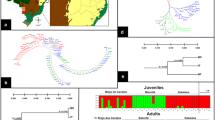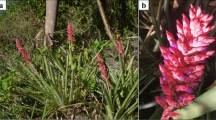Abstract
Encholirium is a genus of 31 xerophytic terrestrial or epilithic bromeliad species endemic to eastern Brazil. Together with Dyckia and Deuterocohnia, it forms the so-called xeric clade of the Pitcairnioideae subfamily of Bromeliaceae. Encholirium species are adapted to rocky landscapes, and many of them are found in the rocky grassland fields of the Espinhaço in the state of Minas Gerais, which is considered the diversity center of the genus. Encholirium species and other bromeliads growing on isolated, island-like habitats like rock outcrops and “inselbergs” are often characterized by high levels of genetic structure and limited gene flow among populations, but there are also exceptions. In the present study, we applied nuclear and chloroplast microsatellite markers to investigate the genetic diversity and population structure of E. magalhaesii L.B.Sm., an endemic species of the Espinhaço, collected in four localities of the Diamantina municipality in southeastern Brazil. Moderate genetic differentiation among localities was revealed by the nuclear markers (Fst = 0.199), whereas genetic structuring was much higher with plastid markers (Fst = 0.496). Estimations of pollen/seed flow ratios suggest that pollen flow is more efficient in maintaining the genetic connectivity among E. magalhaesii populations than seed flow.


Similar content being viewed by others
References
Bandelt HJ, Forster P, Röhl A (1999) Median-joining networks for inferring intraspecific phylogenies. Mol Biol Evol 16:37–48. https://doi.org/10.1093/oxfordjournals.molbev.a026036
Barbará T, Martinelli G, Fay MF, Mayo S, Lexer C (2007) Population differentiation and species cohesion in two closely related plants adapted to neotropical high-altitude inselbergs, Alcantarea imperialis and Alcantarea geniculata (Bromeliaceae). Mol Ecol 16:1981–1992. https://doi.org/10.1111/j.1365-294X.2007.03272.x
Barbará T, Martinelli G, Palma-Silva C, Fay MF, Mayo S, Lexer C (2009) Genetic relationships and variation in reproductive strategies in four closely related bromeliads adapted to neotropical “inselbergs”: Alcantarea glaziouana, A. regina, A. geniculata and A. imperialis (Bromeliaceae). Ann Bot 103:65–77. https://doi.org/10.1093/aob/mcn226
Beerli P, Felsenstein J (1999) Maximum-likelihood estimation of migration rates and effective population numbers in two populations using a coalescent approach. Genetics 152:763–773
Boisselier-Dubayle MC, Leblois R, Samadi S, Lambourdiere J, Sarthou C (2010) Genetic structure of the xerophilous bromeliad Pitcairnia geyskesii on inselbergs in French Guiana—a test of the forest refuge hypothesis. Ecography 33:175–184. https://doi.org/10.1111/j.1600-0587.2009.05446.x
Cavallari MM, Forzza RC, Veasey EA, Zucchi MI, Oliveira GCX (2006) Genetic variation in three endangered species of Encholirium (Bromeliaceae) from Cadeia do Espinhaço, Brazil, selected using RAPD markers. Biodivers Conserv 15:4357–4373. https://doi.org/10.1007/s10531-005-3741-5
de Paula LF, Forzza RC, Neri AV, Bueno ML, Porembski S (2016) Sugar Loaf Land in south-eastern Brazil: a centre of diversity for mat-forming bromeliads on inselbergs. Bot J Linnean Soc 181:459–476. https://doi.org/10.1111/boj.12383
Dick CW, Hardy OJ, Jones FA, Petit RJ (2008) Spatial scales of pollen and seed-mediated gene flow in tropical rain forest trees. Trop Plant Biol 1:20–33. https://doi.org/10.1007/s12042-007-9006-6
Earl DA, von Holdt BM (2012) STRUCTURE HARVESTER: a website and program for visualizing STRUCTURE output and implementing the Evanno method. Conserv Genet Resour 4:359–361. https://doi.org/10.1007/s12686-011-9548-7
Eliades NG, Eliades DG (2009) Haplotype analysis: software for analysis of haplotype data. Distributed by the authors. Forest Genetics and Forest Tree Breeding, Georg-August University Goettingen, Germany. http://www.uni-goettingen.de/en/134935.html. Accessed 17 Nov 2016
Ellstrand NC (2014) Is gene flow the most important evolutionary force in plants? Am J Bot 101:737–753. https://doi.org/10.3732/ajb.1400024
Ennos RA (1994) Estimating the relative rates of pollen and seed migration among plant populations. Heredity 72:250–259. https://doi.org/10.1038/hdy.1994.35
Evanno G, Regnaut S, Goudet J (2005) Detecting the number of clusters of individuals using the software STRUCTURE: a simulation study. Mol Ecol 14:2611–2620. https://doi.org/10.1111/j.1365-294X.2005.02553.x
Excoffier L, Laval G, Schneider S (2005) Arlequin (version 3.0): an integrated software package for population genetics data analysis. Evol Bioinform 1:47–50. https://doi.org/10.1111/j.1755-0998.2010.02847.x
Forzza RC (2005) Revisão taxonômica de Encholorium Mart. ex Schult. and Schult. F. (Pitcairnioideae–Bromeliaceae). Bol Bot Univ São Paulo 23:1–49
Forzza RC, Leme EMC (2015) Three new species of Encholirium (Bromeliaceae) from eastern Brazil. Phytotaxa 227:13–24. https://doi.org/10.11646/phytotaxa.227.1.2
Goetze M, Büttow MV, Zanella CM, Paggi GM, Bruxel M, Pinheiro FG, Sampaio JAT, Palma-Silva C, Cidade FW, Bered F (2015) Genetic variation in Aechmea winkleri, a bromeliad from an inland Atlantic rainforest fragment in Southern Brazil. Biochem Syst Ecol 58:204–210. https://doi.org/10.1016/j.bse.2014.12.010
Gonçalves-Oliveira RC, Wöhrmann T, Benko-Iseppon AM, Krapp F, Alves M, Maria das Graças LW, Weising K (2017) Population genetic structure of the rock outcrop species Encholirium spectabile (Bromeliaceae): the role of pollination vs. seed dispersal and evolutionary implications. Am J Bot 104:868–878. https://doi.org/10.3732/ajb.1600410
Gontijo BM (2008) Uma geografia para a Cadeia do Espinhaço. Megadiversidade 4:7–15
Goudet J (1995) FSTAT (version 1.2): a computer program to calculate F-statistics. J Hered 86:485–486. https://doi.org/10.1093/oxfordjournals.jhered.a111627
Hedrick PW (2005) A standardized genetic differentiation measure. Evolution 59:1633–1638. https://doi.org/10.1111/j.0014-3820.2005.tb01814.x
Hmeljevski KV, Ciampi MB, Baldauf C, Sedrez DosReis M, Forzza RC (2013) Development of SSR markers for Encholirium horridum (Bromeliaceae) and transferability to other Pitcairnioideae. Appl Plant Sci 1:1200445. https://doi.org/10.1093/jhered/esu067
Hmeljevski KV, Nazareno AG, Leandro Bueno M, Reis MS, Forzza RC (2017) Do plant populations on distinct inselbergs talk to each other? A case study of genetic connectivity of a bromeliad species in an Ocbil landscape. Ecol Evol 7:4704–4716. https://doi.org/10.1002/ece3.3038
Jacquemyn H, de Meester L, Jongejans E, Honnay O (2012) Evolutionary changes in plant reproductive traits following habitat fragmentation and their consequences for population fitness. J Ecol 100:76–87. https://doi.org/10.1111/j.1365-2745.2011.01919.x
Keller LF, Waller DM (2002) Inbreeding effects in wild populations. Trends Ecol Evol 17:230–241. https://doi.org/10.1016/S0169-5347(02)02489-8
Krapp F (2013) Phylogenie und evolution der Gattung Dyckia (Bromeliaceae). Ph.D. dissertation, University of Kassel, Kassel, Germany
Krapp F, Wöhrmann T, Pinangé DSDB, Benko-Iseppon AM, Huettel B, Weising K (2012) A set of plastid microsatellite loci for the genus Dyckia (Bromeliaceae) derived from 454 pyrosequencing. Am J Bot 99:2010–2013. https://doi.org/10.3732/ajb.1200153
Lavor P, van den Berg C, Jacobi CM, Carmo FF, Versieux LM (2014) Population genetics of the endemic and endangered Vriesea minarum (Bromeliaceae) in the Iron Quadrangle, Espinhaço Range, Brazil. Am J Bot 101:1167–1175. https://doi.org/10.3732/ajb.1300388
Palma-Silva C, Lexer C, Paggi GM, Barbará T, Bered F, Bodanese-Zanettini MH (2009) Range-wide patterns of nuclear and chloroplast DNA diversity in Vriesea gigantea (Bromeliaceae), a neotropical forest species. Heredity 103:503–512. https://doi.org/10.1038/hdy.2009.116
Palma-Silva C, Wendt T, Pinheiro F, Fay MF, Wendt T, Pinheiro F, Barbara T (2011) Sympatric bromeliad species (Pitcairnia spp.) facilitate tests of mechanisms involved in species cohesion and reproductive isolation in Neotropical inselbergs. Mol Ecol 20:3185–3201. https://doi.org/10.1111/j.1365-294X.2011.05143.x
Petit RJ, Excoffier L (2009) Gene flow and species delimitation. Trends Ecol Evol 24:386–393. https://doi.org/10.1016/j.tree.2009.02.011
Porembski S, Barthlott W (2000) Inselbergs: biotic diversity of isolated rock outcrops in tropical and temperate regions, vol 146. Ecological studies. Springer, Heidelberg
Pritchard JK, Stephens M, Donnelly P (2000) Inference of population structure using multilocus genotype data. Genetics 155:945–959
Queiroz JA, Quirino ZGM, Lopes AV, Machado IC (2016) Vertebrate mixed pollination system in Encholirium spectabile: a bromeliad pollinated by bats, opossum and hummingbirds in a tropical dry forest. J Arid Environ 125:21–30. https://doi.org/10.1016/j.jaridenv.2015.09.015
Rapini A, Ribeiro P, Lambert S, Pirani J (2008) A flora dos campos rupestres da Cadeia do Espinhaço. Megadiversidade 4:16–24
Raymond M, Rousset F (1995) GENEPOP (version 1.2): population genetics software for exact tests and ecumenicism. J Hered 86:248–249. https://doi.org/10.1093/oxfordjournals.jhered.a111573
Rogstad SH (1992) Saturated NaCl-CTAB solution as a means of field preservation of leaves for DNA analyses. Taxon 41:701–708. https://doi.org/10.2307/1222395
Sazima I, Vogel S, Sazima M (1989) Bat pollination of Encholirium glaziovii, a terrestrial bromeliad. Plant Syst Evol 168:167–179. https://doi.org/10.1007/Bf00936097
Schütz N, Krapp F, Wagner N, Weising K (2016) Phylogeny of Pitcairnioideae (Bromeliaceae): evidence from nuclear and chloroplast DNA sequence data. Bot J Linnean Soc 181:323–342. https://doi.org/10.1111/boj.12403
Versieux LM, Wendt T, Louzada RB, Wanderley MGL (2008) Bromeliaceae da Cadeia do Espinhaço. Megadiversidade 4:99–110
Wagner ND, Wöhrmann T, Öder V, Burmeister A, Weising K (2015) Reproduction biology and chloroplast inheritance in Bromeliaceae: a case study in Fosterella (Pitcairnioideae). Plant Syst Evol 301:2231–2246. https://doi.org/10.1007/s00606-015-1226-x
Wanderley AM, dos Santos EKR, Galetto L, Benko-Iseppon AM, Machado ICS (2020) Pollen flow within and among isolated populations of two rare, self-compatible plant species from inselbergs of Northeast Brazil. Plant Ecol 221:229–240. https://doi.org/10.1007/s11258-020-01004-5
Weir BS, Cockerham CC (1984) Estimating F-statistics for the analysis of population structure. Evolution 38:1358–1370. https://doi.org/10.1111/j.1558-5646.1984.tb05657.x
Weising K, Nybom H, Pfenninger M, Wolff K, Kahl G (2005) DNA fingerprinting in plants: principles, methods, and applications. CRC Press, Boca Raton
Wöhrmann T, Weising K (2011) In silico mining for simple sequence repeat loci in a pineapple expressed sequence tag database and cross-species amplification of EST-SSR markers across Bromeliaceae. Theor Appl Genet 123:635–647. https://doi.org/10.1007/s00122-011-1613-9
Wöhrmann T, de Barros Pinangé DS, Krapp F, Benko-Iseppon AM, Huettel B, Weising K (2013) Development of 15 nuclear microsatellite markers in the genus Dyckia (Pitcairnioideae; Bromeliaceae) using 454 pyrosequencing. Conserv Genet Resour 5:81–84. https://doi.org/10.1007/s00122-011-1613-9
Acknowledgements
The authors acknowledge financial support through the PROBRAL program (a joint initiative of CAPES, Coordination for the Improvement of Higher Education Personnel and DAAD, German Academic Exchange Service), as well for granting a sandwich research fellowship for the first author (CAPES Process 12429-12-0). The authors also acknowledge financial support obtained from CNPq (National Counsel of Technological and Scientific Development, Brasília, Brazil) and FACEPE (Fundação de Amparo à Ciência e Tecnologia do Estado de Pernambuco) for a research fellowship (Process IBPG 1228-2.02/11). The authors thank D.S.B. Pinangé and G.A.S. Cruz for valuable suggestions and interesting discussions. We also acknowledge the important suggestions of two reviewers.
Author information
Authors and Affiliations
Contributions
RCGO collected all samples, performed laboratory work, statistical analysis and article writing; TW tested all primers, performed laboratory work, contributed with statistic analysis and article writing; and MGLW, KW and AMBI provided field and laboratory facilities for the work to be done and contributed substantially to the writing of the article.
Corresponding author
Ethics declarations
Conflict of interest
The authors declare that they have no conflict of interest.
Additional information
Publisher's Note
Springer Nature remains neutral with regard to jurisdictional claims in published maps and institutional affiliations.
Electronic supplementary material
Below is the link to the electronic supplementary material.
Rights and permissions
About this article
Cite this article
Gonçalves-Oliveira, R.C., Wöhrmann, T., Weising, K. et al. Genetic structure and gene flow among populations of Encholirium magalhaesii, a rocky grassland fields bromeliad. Braz. J. Bot 43, 283–290 (2020). https://doi.org/10.1007/s40415-020-00600-z
Received:
Revised:
Accepted:
Published:
Issue Date:
DOI: https://doi.org/10.1007/s40415-020-00600-z




